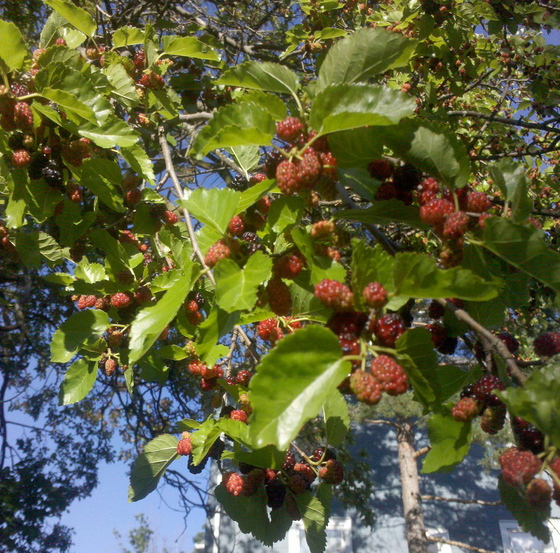Wildcrafting: Mulberries are ripe and ready to be enjoyed

Mulberries ripening in a tree near downtown Ann Arbor. The dark purple fruit is ready to eat, although we have a few white mulberry trees around town as well.
Linda Diane Feldt | Contributor
Mulberries are easy to spot - the squashed berries on the sidewalk give them away every year. People who have the tree often complain about the mess, but if they were picking the berries it wouldn’t be nearly as bad!
Last year I picked mulberries into September. For more than three months I was treating myself daily from the trees I walk by. The taste can vary depending on rain (less flavor) and sun (melt in your mouth) or a dry spell (more concentrated and tart). At least that’s what I found in my daily survey last year.
Berries are easy foraging food. Identify the tree or bush, make certain you have it correctly identified, be certain the berry is safe to eat, and once all that is out of the way eat. And eat some more. And pick some to bring home. And freeze them. And cook with them. And feel rich indeed that there are as many free edible berries to enjoy as you could possibly pick.
The mulberry leaves have a distinct pattern of deeply cut lobes; Google mulberry leaf for images of just the leaf. The berries, as shown above, are very distinct, and are not easily confused with any other berry, especially as they are growing in trees.
Another berry ripe now and usually in a shorter tree is the service berry. Ed Vielmetti just wrote about service berries for AnnArbor.com. Follow his tips for those. They are usually available for a short time; both the birds and the weather wipe them out fast. Mulberries ripen about the same time, overlap with black raspberries for a bit, and then the mulberries continue throughout the summer.
Eat them out of hand. You can make a pie (they tend to be more watery than most berries, so adjust recipes for liquid). You can eat them in your breakfast oatmeal, and you can put them over ice cream. You can bake them into a cake; you can add them to your favorite cornbread recipe.

My Rhodesian Ridgeback, Nala, enjoying her own harvest of mulberries.
Linda Diane Feldt | Contributor
The downside of mulberries is that the stems are hard to remove; they add a bit of unwanted texture to an otherwise soft berry. Also, there is an occasional bug found in the berry. Usually when that happens the whole tree has them for a bit, I’ve avoided trees that seem to have bugs for a few weeks and come back to perfectly clean berries. I don’t know a thing about bugs and mulberries, it has just been something I’ve encountered every couple years. Or I submerge the berries and rinse out any stray bugs, but washing mulberries removes a lot of flavor.
Here is a very simple pie you can make, the first time I ever really appreciated mulberries was with this pie. I was renting a house on the Old West Side with a huge mulberry tree in the backyard, and decided not to waste the fruit. I made this pie for most of the potlucks I attended for the two summers I lived there.
Make a graham cracker crust. I like to use about 3 tablespoons of butter, a handful of almonds (1/3 cup or so), and about 10 graham cracker squares. Use a food processor on pulse to blend until mixed; add a bit more butter if you need to until it holds together when you press a bit between your fingers.
Press that evenly with your fingers into a pie pan, going up the sides an inch or so.
Bake at 350 degrees for 8-10 minutes, until just slightly browned. Let cool.
Mix 1 ½ cups plain yogurt with either ¼ cup honey or ¼ cup maple syrup (you can increase or decrease this if you want). Mix well. Add 1 cup or more mulberries, mix gently, but enough to color the whole thing purple. Spoon into cooled pie crust. Freeze for about 2 hours, or longer.
Thaw about 15 minutes before serving. Serve in a bowl, and you can add more fresh mulberries if you want for yet more variety in texture and taste.
The pie is interesting in the many textures, (the crust with almond pieces, the slightly thawing yogurt, the frozen berries) nice and cold on a hot day, and just the right amount of sweet. Most kids I’ve tried it on do not like it though, and some adults who like their food to be “normal” think it’s a little too weird. But I love the color, the simplicity, and as one more way to enjoy mulberries.
Linda Diane Feldt is a Holistic Health Practitioner, Herbalist, writer and teacher. You can reach her at ldfeldt(at) holisticwisdom.org follow her on Twitter or through her website. Be sure and stop and say hi at the Green Fair this Friday, on Main Street. I’ll be there with cookbooks to sell and many examples of edible and medicinal plants.


Comments
Linda Diane Feldt
Mon, Jun 14, 2010 : 12:54 p.m.
I actually have very little personal experience with elderberries. I've mostly approached them from the river, while canoeing. I didn't like the taste of the berries at all. They have a long history of medicinal use, but again I haven't had the chance to use them or any preparation containing them. I like to write about things more first hand - and so far that is limited to a handful of berries I spit out quickly, looking for something else to eat to take away the bad taste. But who knows what I might find and learn as the season progresses?
Rork Kuick
Mon, Jun 14, 2010 : 8:07 a.m.
At least two kinds of elderberries are fairly common in our area. One (common elderberry) with blackish-purple small fruits with perhaps 50-100 berries per bunch, another with reddish berries that are larger but fewer per bunch. It's pretty easy to learn about them on the web. Common elderberry is blooming right now, and is a spectacular flower of our area, and really is rather common around here. It's likely Linda will cover this plant when the fruits are closer to ready, though I think some people use the flowers as food too (making something like tempura with them). Sugar content of the berries tastes pretty high to me, and they come in large bunches, but they are pretty seedy. Shakespeare mentions making pop-guns from the wood, which is hollow.
A2K
Wed, Jun 9, 2010 : 3:07 p.m.
mmm, Mulberrys are delicious - I remember being warned off of them as a kid (due to what Gran called "mud-butt") but, er, never had an issues with the berries. They make a tasty jam, especially if you sieve the pulp before combining with lemon juice and sugar.
Monica Milla
Tue, Jun 8, 2010 : 5:44 p.m.
Do you know any local sources for elderberry? I have a recipe for elderberry pancakes from a Dutch friend I'm hoping to try!
Britta
Tue, Jun 8, 2010 : 12:22 p.m.
Mulberry trees do not grow here. First I learned about them by the song of "So we go round the mulberry tree". Then I learned from my Iranian refugee students what they tasted like trough tasting dried ones. I still buy them now and then at our indoor market here. But they are white?
Tammy Mayrend
Tue, Jun 8, 2010 : 7:10 a.m.
That sounds like a yummy pie - We made MANY mulberry peis last year and the kids TOTALLY enjoyed eatting them up! Well that and harvesting them so they got purple hands and feet!